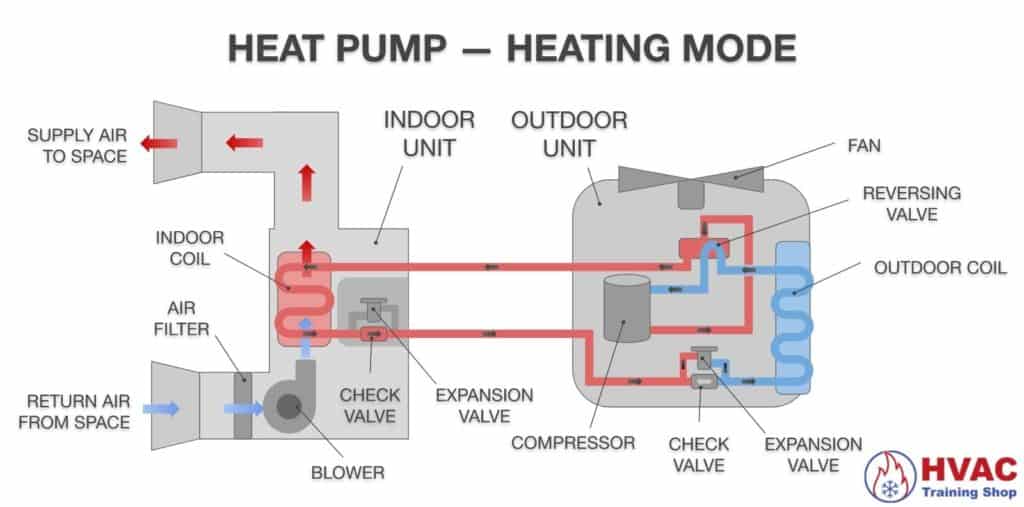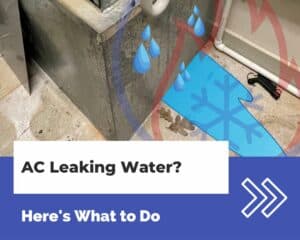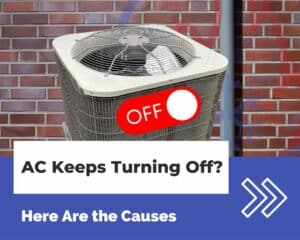A heat pump works in the winter by taking heat from the outside air and moving it into your home. This is just like an AC in reverse.
Technically speaking, a heat pump is an air conditioner with a reversing valve. The reversing valve allows the air conditioner to operate in reverse—heating your home instead.
The biggest advantage of using a heat pump in the winter is that they are incredibly energy efficient. In normal situations, heat pumps use less energy than the amount of heat they deliver to your home.
In this article, I’ll explain the details on how a heat pump works in the winter to heat your home. I’ll also discuss the pros and cons of using a heat pump in cold climates, and go over backup heating systems in heat pumps.
Before going further, check out my diagram below that shows how a heat pump works in winter:

Using a heat pump in cold climates
Historically, heat pumps have been suited to more moderate climates, such as the southern United States. This is because their efficiency takes a nosedive when outdoor temperatures dip below freezing.
Worse yet, a heat pump will shut off completely when the temperature drops below a certain level, and will switch to using backup heat instead.
However, some newer heat pump models that have come on the market within the last 10 years are able to perform well below freezing temperatures—some even below 0° F.
These newer models of heat pumps use variable-stage and/or multiple compressors to adjust their heat output based on the heating demand of the home. Additionally, the size of the indoor and outdoor coils have been optimized to allow for increased heating at lower outdoor temperatures.
If you’re considering getting a heat pump installed, be sure that the heat pump will be able to perform within the range of temperatures experienced in your area. If you live in a cold climate, then be sure that your heat pump is sized properly (should be sized for heating load instead of cooling load). It should also be rated to perform at below-freezing temperatures.
Using a heat pump below freezing
While heat pumps work below freezing, they aren’t very efficient. The exception is modern, multi-stage heat pumps that are designed to work at temperatures below 0° F.
When the outdoor temperature drops below the minimum operating temperature of the heat pump, the heat pump will shut off and the backup heating system will engage.
The backup heating system is designed to provide heating when the outside air temperature is too low for the heat pump to operate.
Heat pump backup heating systems
When outdoor temperatures drop below freezing, most heat pumps are not effective on their own. This is when backup heating systems come into play.
A backup heating system usually consists of one of the following:
- Electric resistance heating. Many heat pump systems have heat strips installed in them. Heat strips work the same way as electric space heaters do—an electric current runs through a coil that heats up.
- Gas heating. Also known as furnaces, gas heaters are a tried-and-true method of heating your home. They work by burning gas to create a flame that heats up your home.
Electric heat strips are cheap to install. However, they usually cost more to run since they use electricity to heat your home.
Gas furnaces are more expensive to install. However, they usually cost less to run when compared to electric heat strips.
If you have natural gas available in your area, then a heat pump/gas furnace “dual-fuel” setup is a good candidate for backup heating.
If you don’t have natural gas available in your area, then your only backup heating option is electric heat strips.
One important thing to keep in mind is that your backup heating system will only turn on when outdoor temperatures drop below the level at which your heat pump can operate. If that only happens for a few days out of the year, then the efficiency of your backup heat is not that important since you won’t be using it too often.
At what temperature is a heat pump not effective?
Most heat pumps are not effective when the outdoor temperature is below 25° – 30° F. Once the outdoor temperature goes below this level, the heat pump will use much more electricity to heat your home.
For this reason, most heat pumps are equipped with a supplemental heat source such as an electric resistance heater. The supplemental heat source will turn on when the outdoor temperature goes too low for the heat pump to be effective on its own.
So does that mean that you shouldn’t get a heat pump if you live in an area where the temperature drops below 25° – 30° F? Not at all. As long as the temperature stays above these levels most of the time, then your heat pump will work just fine. When the temperature drops below 25° – 30° F, then your heat pump’s supplemental heating will take over.
One thing that I should mention is that a lot of newer heat pumps are able to operate in extremely low temperatures—as far down as 0º F, and sometimes even lower. So if you live in a cold northern climate, then a heat pump is a good option.
Another thing to look out for is frost on your heat pump. When temperatures drop really low, excessive amounts of frost can build up on your heat pump.
Usually frost is not a problem, since heat pumps have built-in defrost mechanisms in place. However, sometimes the built-in defrost cycle in the heat pump can fail, and your’re left with a frozen heat pump.
If you have a heat pump that’s freezing up, check out my article below for more advice.



